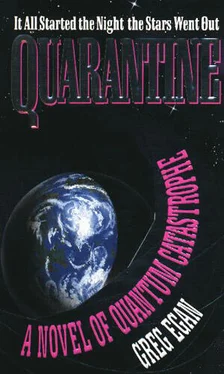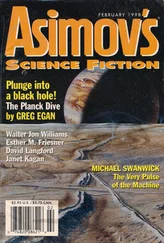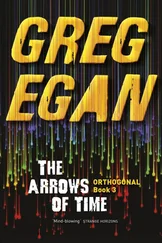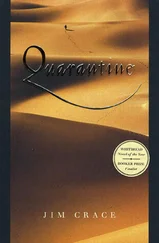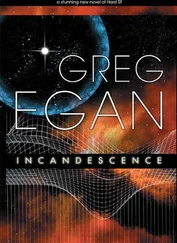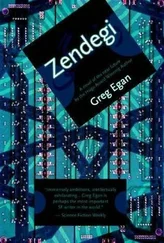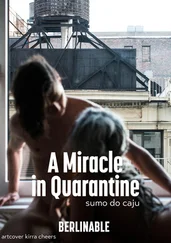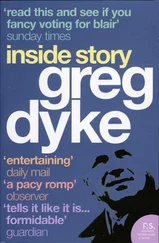I slice open a ground-floor window, and slip into an unlit room, a lab of some kind. P2adapts my vision rapidly to maximum sensitivity, for what that's worth, but it's Culex's map that helps me navigate past obstacles at a reasonable speed. Fixed obstacles, that is; whenever I see' a chair or a stool outlined in my ghost vision, I slow down and reach out to ascertain its current position.
The corridor, too, is in darkness, but I see red not far to my left as I leave the lab, and a second region still under surveillance comes within a centimetre of the doorway to the stairs. I'm about to turn the handle, when I realize that the elbow-shaped door-closing mechanism is on the verge of poking into the danger zone; P5makes it clear that I don't stand a chance of squeezing through the permissible crack. I reach up and snap the device at the joint, then fold the two limp halves flush against the door.
I descend to the lower basement. The chameleons have done their best to give me the widest possible access to every floor, but this place seems to have been sparsely protected to start with. With no live cameras nearby to catch the spill, I risk using a flashlight, bringing detail to my ghost vision's wireframe sketch. There are bulk containers of solvents and reagents; a row of horizontal freezers; a centrifuge sitting against the wall, opened up and spilling circuit boards, as if in mid-repair, or mid-cannibalization.
I reach the no data region. It's a large, square room, oddly adrift in the middle of an area that's otherwise undivided, and it looks — and smells — like a recent construction. But if Laura is in there, why would they have gone to so much trouble to house her? Not to keep her discreetly hidden, that's for sure; this ad hoc prison, if that's what it is, could hardly be more conspicuous.
I circle the room; there's only one door in. The lock is no great challenge; a little probing, then one carefully directed magnetic pulse is all it takes, inducing a current in the circuit that operates the release mechanism. I draw my gun, pull the door open — and find myself staring at another wall, just two or three metres away.
I step through cautiously. The space between the walls is empty, but the second wall fails to join up with the first, on either side. Before going any further, I close the door behind me and plant a small alarm at the top of the frame.
When I reach the corner on my right, it's clear that the two walls are concentric; I keep going, and round the next corner there's a door in the inner wall. The lock is of the same cheap design as the first. I wish I knew the point of this bizarre setup, but I can worry about that later; what matters right now is whether or not Laura is buried in here, somewhere.
I open the second door, and the answer is no, but —
There's a bed, unmade since it was last slept in, the bedclothes drawn back on one side where the occupant presumably slipped out. A toilet, a sink, a small table and chairs. On the far wall, there's a mural of flowers and birds, just like the one in Laura's room in the Hilgemann.
The bed is still faintly warm. So where have they taken her, in the middle of the night? Perhaps she's suffered complications, and they've had to move her to a hospital. I spend thirty seconds exploring the room, but there's nothing much to examine; the mural, though, says it all. Laura was here, just minutes ago, I'm sure of that; it's pure bad timing that I've missed her.
And she may still be in the building. Upstairs, undergoing a midnight brain scan? BDI may be so eager to complete their contract — whatever that entails — that they're working round the clock.
Leaving the inner room, I almost turn right, retracing my steps, taking the shortest route out — but then I change my mind and decide to complete my circumnavigation of the gap.
The woman standing just round the corner, leaning wearily on a walking frame, looks exactly like Han Hsiu-lien. She glances up at me, and bursts into tears. I step forward quickly, and administer a tranquillizing nasal spray. She goes limp; I catch her under the arms and put her over my shoulder. Not the smoothest ride, but I'm going to need my hands free. The walking frame is a good sign; she may not be entirely recovered, but no doubt she can be moved without too much harm. Once I've got her out of the building, I can call for an ambulance — while I'm cutting a hole in the fence.
I'm three paces out of the second doorway when a male voice behind me says calmly, 'Don't turn round. Drop the gun and the flashlight, and kick them away.' As he speaks, I feel a small, sharply defined patch of warmth alight on the back of my skull — an infrared laser on minimum strength. This is more than a palpable warning that I'm targeted; if the weapon is on auto, the beam's scatter is being monitored, and any sudden movement on my part would trigger a high-intensity pulse in a matter of microseconds.
I comply.
'Now put her down, carefully, then put your hands on top of your head.' I do it. The laser tracks me smoothly all the way.
The man says something in Cantonese; I invoke Deja Vufor a translation: 'What do you want to do with him?'
A woman replies, 'I'll put him out of it.'
The man says, in English, 'Please keep very still.'
The woman moves in front of me, holstering a gun. From a pouch on her belt beside the holster, she produces a small hypodermic capsule. Stepping over Laura, she takes hold of my jaw in one hand — I lower my heart rate — slides the needle into a vein in the side of my neck — I constrict blood flow to the area — then squeezes the capsule.
Reduced circulation will buy me a few seconds, at best, but that should be long enough for PI to make an assessment. If this is a substance that the mod can neutralize, then now is the time to move; unless the plan is to incinerate me when I slump under the drug's effects, the laser must be off auto. If I feign loss of consciousness, stumble, swing the woman around as a shield, take her gun …
But PI gives no report. I try to twitch a finger, and fail. A moment later, I black out.
I wake, lying on my side on a concrete floor, naked. My arms are aching, but when I try to move them, cool metal presses against my wrists. I look around; I'm in a small, narrow storeroom lit by a single high window. My hands are cuffed behind me to a shelving rack, packed with laboratory glassware, which runs the length of the wall P5has lost track of my location; it relies on a mixture of perceptual cues, balance sense and proprioception, which is accurate to the millimetre when you're conscious and moving on foot, but totally useless when you've been knocked out and lugged somewhere. It does claim to have kept the time, though: 15:21, January 5th. The clocks in several other mods agree, and I doubt that a drug would have screwed them all up identically. In fifteen hours, I could have been moved anywhere on the planet … anywhere, that is, judging from the light, where's it's mid-afternoon or mid-morning at 15:21 Central Australian time. Belatedly, it occurs to me to scan the layout of the building in my head for any rooms with matching dimensions, and I find one on every floor. Culex saw nothing worth photographic snapshots in any of them, but the wireframe outlines it recorded indiscriminately are detailed enough to place me on the fourth floor.
I'm wearing two pairs of handcuffs; one pair has been threaded through a slot in one of the shelving rack's vertical supports. The shelves aren't anchored to the wall and just shifting my weight slightly sets the glassware rattling. I could try working the chain of the cuffs against the edge of the slot, but even if I'm not under surveillance, all that's likely to achieve is an avalanche of glass.
Читать дальше
